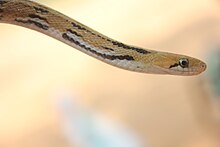Trinket snake
| Trinket snake | |
|---|---|

| |
| Close up shot of a common trinket snake captured near Patnagarh, Odisha, India. | |
| Scientific classification | |
| Kingdom: | |
| Phylum: | |
| Subphylum: | |
| Class: | |
| Order: | |
| Suborder: | |
| Family: | |
| Subfamily: | |
| Genus: | |
| Species: | C. helenus
|
| Binomial name | |
| Coelognathus helena (Daudin, 1803)
| |
| Synonyms | |
| |
The trinket snake (Coelognathus helena) is a nonvenomous constrictor species of colubrid snake native to south Central Asia.
Geographic range
C. helena is found in Sri Lanka, southern India, Pakistan (Sindh), Nepal, and Bangladesh.
Its type locality is "India: Vishakhapatnam" (Daudin, 1803).
Description
- See snake scales for terms used.
The rostral is a little broader than deep, and visible from above. The suture between the internasals is much shorter than that between the prefrontals. The frontal is as long as its distance from the end of the snout, but shorter than the parietals. The loreal is somewhat longer than deep. One large preocular and two postoculars are present. The temporals are arranged 2+2 or 2+3. There are 9 (exceptionally 10 or 11) upper labials, and the fifth and sixth (or fourth, fifth, and sixth) enter the eye. There are 5 or 6 lower labials in contact with the anterior chin shields. The anterior chin shields are as long as or a little longer than the posterior chin shields.[2]
The dorsal scales are in 23 to 27 rows at midbody, smooth, or feebly keeled on the posterior part of the body and on the tail. The ventrals number 220-265; the anal plate is entire; and the subcaudals number 75-94.[2]
The young are pale brown above, with black crossbands, each crossband enclosing four to six white ocelli. The adults are darker brown, with a transverse series of squarish black spots, or with more or less distinct traces of the color pattern of the young. There is a vertical black streak below the eye, and an oblique black streak behind the eye. Some specimens have a white, black-edged collar; others have two black longitudinal streaks on the head; and others are intermediate in this respect. The lower parts are yellowish, with or without a few small black spots, sometimes with a more or less distinct festooned marking on each side.[2]
Adults may attain a total length of 4.5 ft (1.4 m), which includes a tail 10 in (25 cm) long.[2]
Subspecies
In addition to the nominotypical subspecies, Coelognathus helena helena, the subspecies Coelognathus helena monticollaris is recognized as being valid.[1]
Habitat
A terrestrial snake, C. helena lives in termite mounds, but also prefers low heights, old trees, wood piles, around old houses, dense vegetation, etc.
Diet
The trinket snake feeds on rodents, other small mammals, and lizards.
Behaviour
Diurnal and highly active, C. helena is noted for its temper and will strike repeatedly if molested. The males of this species are generally more aggressive than the females. Its bites are often very damaging due to its inward pointing teeth.
Gallery
-
Sideview of trinket snake head
-
Pattern on first half of body
-
Pattern on second half of body

References
- ^ a b "Coelognathus helena ". The Reptile Database. www.reptile-database.org.
- ^ a b c d Boulenger GA. (1890). The Fauna of British India, Including Ceylon and Burma. Reptilia and Batrachia. London: Secretary of State for India in Council. (Taylor and Francis, printers). xviii + 541 pp. (Coluber helena, pp. 331-332).
Further reading
- Boulenger, George A. (1894). Catalogue of the Snakes in the British Museum (Natural History). Volume II., Containing the Conclusion of the Colubridæ Aglyphæ. London: Trustees of the British Museum (Natural History). (Taylor and Francis, printers). xi + 382 pp. + Plates I-XX. (Coluber helena, pp. 36-37).
- Das, Indraneil. (2002). A Photographic Guide to Snakes and other Reptiles of India. Sanibel Island, Florida: Ralph Curtis Books. 144 pp. ISBN 0-88359-056-5. (Coelognathus helena, p. 32).
- Daudin, F.M. (1803). Histoire Naturelle Générale et Particulière des Reptiles. Vol. 6. Paris: F. Dufart.
- Helfenberger, Notker. (2001). "Phylogenetic relationship of Old World Ratsnakes based on visceral organ topography, osteology, and allozyme variation". Russ. J. Herpetol. (Suppl.), 56 pp.
- Kornacker, P. (1986). "Die indische Schmucknatter ". Herpetofauna 8 (44): 10.
- Kornacker, P. (1988). "Bemerkungen zur Biologie, Haltung Zucht von Elaphe helena (Daudin 1802)". Herpetofauna 10 (57): 27-33.
- Mehta, R.S. (2003). "Prey-handling behavior of hatchling Elaphe helena (Colubridae)". Herpetologica 59 (4): 469-474.
- Niehaus, Guido; Schulz, Klaus-Dieter. (1987). "Die hinterasiatischen Kletternattern der Gattung Elaphe. Teil XI Elaphe helena (Daudin, 1803)". Sauria 9 (4): 3-7.
- Schulz, K.-D. (1996). Eine Monographie der Schlangengattung Elaphe Fitzinger. Berg (CH): Bushmaster. 460 pp.
- Schulz, Klaus-Dieter. (1996). A monograph of the colubrid snakes of the genus Elaphe Fitzinger. Koeltz Scientific Books. 439 pp.
- Smith, M.A. (1943). The Fauna of British India, Ceylon and Burma, Including the Whole of the Indo-Chinese Sub-region. Reptilia and Amphibia, Vol. III.—Serpentes. London: Secretary of State for India. (Taylor and Francis, printers). xii + 583 pp. (Elaphe helena, pp. 149-150).
- Utiger, Urs; Helfenberger, Notker; Schätti, Beat; Schmidt, Catherine; Ruf, Markus; Ziswiler, Vincent. (2002). "Molecular systematics and phylogeny of Old World and New World ratsnakes, Elaphe Auct., and related genera (Reptilia, Squamata, Colubridae)". Russ. J. Herpetol. 9 (2): 105-124.
- Wall, F. (1921). Ophidia Taprobanica or the Snakes of Ceylon. Colombo, Ceylon [Sri Lanka]: Colombo Museum. (H.R. Cottle, Government Printer). xxii + 581 pp. (Coluber helena, pp. 197-203, Figure 42).



